#PHP syntax
Explore tagged Tumblr posts
Text
PHP Variables : Syntax, Types, Scope, and Best Practices
Learn all about PHP variables including syntax, data types, variable scope, and best practices. A beginner-friendly guide to mastering PHP variables with examples. PHP Variables – A Complete Guide for Beginners PHP (Hypertext Preprocessor) is a powerful server-side scripting language widely used for web development. One of the foundational concepts in PHP—and in any programming language—is…
#PHP array variable#PHP for beginners#PHP global variable#PHP local variable#PHP programming#PHP static variable#PHP string variable#PHP syntax#PHP tutorial#PHP variable example#PHP variable naming#PHP variable scope#PHP variable types#PHP variables
0 notes
Text

PHP Is Scripting Language that is used to create websites, applications, customer relationship management systems and more.
0 notes
Text
Haskell > anything else
Haskell is the best programming language because it lets you write a fully functioning web server with three lines of code and zero understanding of how anything works You don't write programs, you declare intentions, and the compiler decides if you're worthy Every other language lets you make mistakes. Haskell waits patiently then destroys your ego at compile time Besides, who needs to 'build skill' in programming anyway?
Not even comparable to python, which is just... so annoyingly uncomplicated and pointless (to make good python syntax you need to make it as un-python as possible) and javascript? Who needs fast languages anyway? So unsatisfying And don't even get me started on C, C++ or C#, which are literally the same language by the way Rust? Bro, just send me the virus already. I don't care PHP? What does that even stand for? Poverty Holding Person? Like you? Java? You stopped being relevant about thirty years ago Swift? Buddy, I do not care about your apple vision pro R? You couldn't even spare another letter? What are you, C-- or something? Ruby? Just admit that Ruby on Rails died last decade... Go? Go where? Out the door? Because currently, that is what Go developers are being asked to do by employers Perl? I don't even know what that language is
#the most evil blog on tumblr#code#coding#haskell#python#C#C++#Csharp#Rust#PHP#Java#Javascript#Swift#R#Ruby#ruby on rails#go#perl#IDE#what are other coding words#programming#text#typed#meme#funny#funny meme#xd#I'm right#Hot take#the most evil blog on tumblr (again mwahaha)
6 notes
·
View notes
Text
Tierlist part 4: Python
Python is an interesting case. On one hand i absolutely hate it. The dynamic type system is not fun to work with especially when you accidentally have created a reference to an array instead of cloning it. I have never gotten round to completely understanding how class work cause it just seems like a mess. On the other hand it's a great toy. There is just a bunch of syntax like for else and the most important list comprehension that makes it an ideal playground for the writing the most cursed code. It's a good entry to code golfing because of that. So that leaves the question of where to put it. So uhmmm, let me just find the knife and do a little dissecting. There. Perfect. A tier as a toy. D tier as a language to write actual projects in.
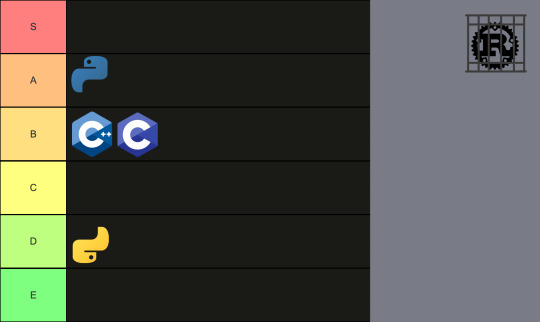
Part 3
#Possibly a bit mean towards python but i can't be kind if there is dynamic types. I am C-official after all#Seems its a good time to add conlangs to the poll#Somehow i haw voted the most popular option each time. That will probably change soon.#Im at work now and should get back to write php :(#c-official
16 notes
·
View notes
Text


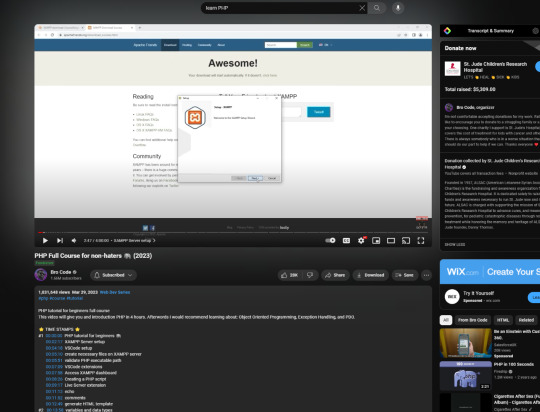
Saturday 2nd March 2024 - [ Week 1 Day 1 ]
First programming language in the list to tackle is PHP~!! I've heard of it before but never actually learnt how to program using it! I've heard you can build websites using PHP!
For resources I am using BroCode on YouTube and Codecademy's 'Learn PHP' course! I can start off with them and still look around for other small resources I can use!
Today I will be studying the fundamentals, of course:
Syntax
Variables
Constants
Comments
Data Types
Operators

💌 Day 1: What are you most looking forward in learning PHP?
Learning how people use PHP to make websites! Since I love Web Development, I'm excited to finally study and programming in PHP to make web-based projects in the future!

#5in5weeks#study challenge#programming#coding#studyblr#codeblr#studying#comp sci#progblr#tech#programmer#php#study#study hard#studyspiration#night study#stay productive
20 notes
·
View notes
Text
Still Looks A Lot Like Love
Evening Musings June 12, 2025 · 5:57 PM
It’s almost 6 in the evening and I meant to post this sometime around midday—but as it always goes, things came up. Good things, though. And before this day ends, I just wanted to put this one out there. Maybe one more will follow before I go to bed tonight.
Today was a good day. A day well spent. Thank God for legal holidays and long weekends. Truly, sometimes we forget how vital it is to enjoy the little things in life—the ones that bring peace without asking for anything in return.
It’s nice to sit in front of a computer and not have to write in code. Not PHP, not JavaScript, not HTML, not even Python. To not worry whether the syntax will work, whether the logic is sound, or if something’s breaking where it shouldn’t. It’s just nice... not to think about work.
Just to type—whatever the brain needs to let go of.
Funny how, even though I haven’t done this in years, it’s like I never left. Fandom has always kept me afloat. But this—this is the one where I had to learn to come back to myself. To write just because the words sound good together. Because a photo or a drawing makes something stir in the chest and the only way to soothe it is to shape it into story.
It’s freeing. To not think: How do I fix this program? To not wonder: Why isn’t this running? To not hear the nagging: It’s not working the way it should.
No. Today, I got a breather.
Usually, that breather is on my Instagram—through photographs and short captions, little visual stories that people can read however they like. But this is something else entirely. And I’m thankful for it too.
Anyway—I'm rambling.
I created this post because I felt like the morning arc needed a companion. And knowing me, this one will have a companion too. Sometimes I really hate how my brain works in pieces. It never settles. It never says, “That’s enough.” It always asks, “And then what?”
Still, here we are.
I found something really cute. And since this little corner of the internet is my diary now, I’m posting it here. To those of you reading—thank you. If you find anything here worth taking, please take it. I don’t mind at all.
So anyway— Here it goes. :) Also—just a note: the images I’ve posted along with this entry are how I imagine Aldo would look in the moment. Thoughtful. Quiet. On the brink of something soft and world-changing. They helped the story form in my head. Somewhere Quieter
The door clicked shut behind him.
Aldo stood in the soft dark of his apartment, the hush of evening still clinging to his coat. He didn’t move for a long moment. Just breathed—slow, careful—as though any sudden motion might undo the fragile echo of what had just happened.
He touched his lips. Twice.
The elevator had already descended. Goffredo was gone. But the feeling lingered, like warmth left in a chair just vacated, or the scent of coffee long after the cup had been emptied.
He took off his coat and laid it gently over the back of the chair. Sat. Let the silence swell around him.
And then—almost involuntarily—he began to wonder.
How had it begun?
Not the kiss. Not even the dinner. No, it began somewhere earlier, quieter. Less pronounced. The sort of moment you don’t notice until it’s already changed something.
Aldo remembered the café.
Just a few days after the conclave. Rome still bristled with whispers and fresh judgments. The marble corridors hadn’t yet settled. Everyone was watching everyone—still guessing who had hoped for what.
He’d gone to a small café tucked beside a bookseller, a place with almond pastries and poor lighting and exactly the kind of solitude he needed. He was reading something—not for work, for once. A biography. He’d made it halfway through his espresso when the seat across from him scraped back.
Goffredo.
Wearing an ivory suit, of all things. Baby-blue shirt, slightly wrinkled at the sleeves. No cassock. Just a man. A man carrying a small box of persicata—the kind of peach-sugar sweet no one ever admits to liking but everyone secretly does.
“I remembered you liked these,” Goffredo said, setting the box down between them.
“I didn’t know I’d said that.”
“You didn’t.”
A pause.
“You always take the ones from the snack table,” Goffredo added. “Even when they’re too sweet.”
Aldo had blinked at him, unsure whether to be annoyed or oddly touched.
Goffredo ordered a macchiato. Stayed.
No speeches. No posturing. No apologies, either—just... presence. Uncloaked. Quiet.
“After all that,” Aldo had said at last, gesturing vaguely, “I thought we might go back to pretending the other didn’t exist.”
Goffredo had tilted his head. “We could. But I think I’ve grown tired of pretending.”
They hadn’t become friends overnight. They didn’t become anything, really. But after that afternoon, they kept running into each other. At meetings. In the corridors. On accident, then on purpose.
Small things changed. Goffredo stopped cutting into Aldo’s points during debates. Aldo started leaving memos with room for replies. One afternoon, he caught Goffredo holding the door for him a little too long. Another time, Goffredo found an annotated article left on his desk—with Aldo’s handwriting in the margins.
Eventually, they shared coffee. Then lunches. Sometimes walks.
The friendship, when it came, arrived quietly.
Aldo remembered one late afternoon in the library—just the two of them and the distant tapping of a rainstorm against the stained-glass windows. Goffredo had asked, not unkindly, “When did you stop hating me?”
Aldo had shrugged. “I don’t know. When did you stop being insufferable?”
They’d both smiled. It had been easy, for once.
And then, one morning, over breakfast in the refectory, Aldo told Thomas, Raymond, and Giulio—offhandedly, almost as an afterthought—that he’d been “spending time” with Goffredo.
Thomas raised an eyebrow. “Spending time as in... diplomacy?”
Raymond had grinned behind his coffee. Giulio only hummed knowingly and stabbed a boiled egg.
“It’s not like that,” Aldo insisted.
“It’s never like that,” Giulio replied. “Until it is.”
Aldo had laughed them off. But he remembered how warm his face felt.
And now, tonight—after the kiss—he wondered if they had all known before he did.
The warmth had never left.
Aldo leaned back in his chair now, in his quiet apartment, letting the memories fade into stillness again. On the table in front of him sat a small, unopened box of persicata. He didn’t know when Goffredo had left it there.
He smiled.
And for the first time in years, Aldo felt like he was at the beginning of something—not grand, not inevitable, but real.
Something he could choose.
And maybe, just maybe, something that had already chosen him.


#bellesco#goffredo tedesco#aldo bellini#soft bellesco#bellesco alternative universe#au#alternative universe#aldo x goffredo#goffredo x aldo#goffredo tedesco x aldo bellini#giulio sabbadin#thomas lawrence#raymond o' malley#conclave#software developer#software engineer#online diary#tumblr diary#Spotify
6 notes
·
View notes
Text
ok. I think some of the stuff I was doing in JS might be a smidge more practical with PHP, it seems a bit more straightforward in handling data on the server side of things. Which is really what I want, to just have something compile the relevant data and hand that to the client, rather than running a bunch of stuff client-side.
While JS does do some stuff like that, it seems a bit more particular about how it does it. and tbh I don't feel like... that compelled to try stuffing around with modules just yet. it feels like I'm adding more stuff to an already stupidly dense piece of code.
I don't want to keep adding more complexity to it if there's a simpler, more direct way of doing the things I want it to do that might give me a chance to unravel some of the denser parts of it.
PHP also seems like a similar structure to JS in terms of language and syntax, which I'm grateful for.
although, I'm not rushing to implement anything atm, I'm going to try to like, pace myself and just spend a bit of time reading up on more web dev concepts so I'm not fumbling around or brute-forcing anything.
2 notes
·
View notes
Text
So there's this indie game I love - Fl0ppy D!sk
And it had an online mode, which doesn't work anymore
So today, as a challenge, I disassembled it, found the part relating to the online part, changed the address to localhost, reverse engineered the server, and made it in php (using chatgpt because it was 99% syntax 1% content so fuck learning php for this, I'll learn it another time)
And it fucking works
So now I just got to find how to register a server, register mine, contact the original maker for permission, and reupload the working version!
5 notes
·
View notes
Text
When deciding between Laravel and Symfony, it's essential to consider your project needs. Laravel shines with its user-friendly syntax and extensive out-of-the-box functionalities, making it ideal for rapid development and handling common web application tasks with ease. Its vibrant community and ecosystem offer a wide range of packages, which can be a huge time-saver for developers looking to implement complex features quickly.
On the other hand, Symfony is known for its robustness, flexibility, and scalability, making it a preferred choice for large, enterprise-level applications. With a component-based architecture, Symfony allows developers to pick and choose components, making it highly customizable. If you value performance and long-term support, Symfony might be the better choice, while Laravel is perfect for projects needing fast deployment and intuitive development.
2 notes
·
View notes
Text
PHP Variables : Syntax, Types, Scope, and Best Practices
Learn all about PHP variables including syntax, data types, variable scope, and best practices. A beginner-friendly guide to mastering PHP variables with examples. PHP Variables – A Complete Guide for Beginners PHP (Hypertext Preprocessor) is a powerful server-side scripting language widely used for web development. One of the foundational concepts in PHP—and in any programming language—is…
#PHP array variable#PHP for beginners#PHP global variable#PHP local variable#PHP programming#PHP static variable#PHP string variable#PHP syntax#PHP tutorial#PHP variable example#PHP variable naming#PHP variable scope#PHP variable types#PHP variables
0 notes
Text
Top 20 Backend Development Tools In 2023
Backend development plays a crucial role in the operation and performance optimisation of web and mobile applications, serving as their foundational framework. In the context of the dynamic technological environment, it is imperative for developers to remain abreast of the most recent and effective backend development technologies. In the year 2023, a plethora of advanced tools have surfaced, leading to a significant transformation in the approach to backend development. Reach out to Nivida Web Solutions - a noted Web development company in Vadodara and let's craft a website that sets you apart.
This analysis aims to examine the leading 20 backend development tools projected for the year 2023, which possess the potential to optimise operational effectiveness, raise work output, and achieve exceptional outcomes.
1. Node.js:
Node.js continues to be a prominent contender in the realm of backend development, offering a resilient framework for constructing scalable, server-side applications through the utilisation of JavaScript. The asynchronous and event-driven nature of the system renders it highly suitable for real-time applications and microservices.
2. Express.js:
Express.js is a Node.js framework that offers a basic and flexible approach to backend development. It achieves this by providing streamlined routing, efficient handling of HTTP requests, and effective management of middleware. The software possesses a high degree of extensibility, allowing developers to create tailored solutions.
3. Django:
Django, a renowned Python framework, is widely recognised for its exceptional performance, robust security measures, and remarkable scalability. The framework adheres to the "batteries-included" principle, providing a wide range of pre-installed functionalities and libraries that enhance the speed and efficiency of the development process.
4. Flask:
Flask, an additional Python framework, is characterised by its lightweight nature and user-friendly interface. The framework offers fundamental capabilities for backend development and enables developers to incorporate additional functionalities as required, thus rendering it very adaptable.
5. Spring Boot:
Spring Boot, which is built on the Java programming language, streamlines the process of creating applications that are ready for deployment by employing a convention-over-configuration methodology. The platform provides a variety of functionalities to construct resilient and scalable backend systems. Embark on a digital journey with Nivida Web Solutions - the most distinguished Web development company in Gujarat. Let's create a stunning, functional website tailored to your business!
6. Ruby on Rails:
Ruby on Rails, also referred to as Rails, is renowned for its high level of efficiency and user-friendly nature. The framework employs the Ruby programming language and places a strong emphasis on convention over configuration, facilitating expedited development processes.
7. ASP.NET Core:
ASP.NET Core is a highly adaptable and efficient cross-platform framework that facilitates the development of backend solutions through the utilisation of the C# programming language. The product provides exceptional performance, robust security measures, and effortless compatibility with many systems.
8. Laravel:
Laravel, a framework developed using the PHP programming language, is well-acknowledged for its sophisticated syntax and user-centric functionalities. The utilisation of this technology streamlines intricate operations such as authentication, caching, and routing, hence facilitating an expedited development procedure.
9. NestJS:
NestJS is a Node.js framework that adheres to the architectural patterns established by Angular, hence exhibiting a progressive nature. The software possesses a high degree of modularity, hence facilitating the scalability and maintenance of applications. NestJS places a strong emphasis on the principles of maintainability and testability.
10. RubyMine:
RubyMine is an influential integrated development environment (IDE) designed specifically for the purpose of facilitating Ruby on Rails development. The software provides advanced code assistance, navigation, and debugging functionalities, hence augmenting the efficiency of Ruby developers. Looking for a standout web presence? Let Nivida Web Solutions - the most popular Web development company in India craft a website that impresses. Reach out now and let's get started!
11. PyCharm:
PyCharm, an integrated development environment (IDE) designed specifically for the Python programming language, is extensively utilised in the realm of backend development. The software offers intelligent code completion, comprehensive code analysis, and integrated tools to facilitate fast development and debugging processes.
12. IntelliJ IDEA:
IntelliJ IDEA, a widely utilised integrated development environment (IDE), provides comprehensive support for multiple programming languages, encompassing Java, Kotlin, and many more. The software is renowned for its advanced coding assistance and efficient capabilities, which greatly assist backend developers in producing code of superior quality.
13. Visual Studio Code (VSCode):
VSCode is a code editor that is known for its lightweight nature and open-source nature. Due to its extensive extension library and high level of customizability, this platform is widely favoured by backend developers due to its versatile nature.
14. Postman
Postman is an efficient and powerful application programming interface (API) testing tool that streamlines the process of doing backend testing and facilitating communication among developers. This tool facilitates the efficient design, testing, and documentation of APIs, hence assuring a smooth integration process. Every click counts in the digital world. Partner with Nivida Web Solutions - one of the top Web development companies in Vadodara to create a user-friendly, engaging website. Choose Nivida Web Solutions to boost your online impact!
15. Swagger:
Swagger, currently recognised as the OpenAPI Specification, serves to enable the process of designing, documenting, and evaluating APIs. The standardised structure of API description facilitates the seamless and uncomplicated integration process.
16. MongoDB:
MongoDB, a widely adopted NoSQL database, has notable advantages in terms of scalability, flexibility, and superior performance. Due to its capacity to effectively manage substantial quantities of data and accommodate various data models, it is extensively employed in the realm of backend development.
17. PostgreSQL:
PostgreSQL, an open-source relational database management system, is widely recognised for its robustness, adaptability, and comprehensive SQL capabilities. This option is highly recommended for projects that necessitate a resilient backend data repository.
18. Redis:
Redis is an essential component for caching and real-time analytics due to its ability to store data structures in memory. The indispensability of this technology lies in its high performance and its capability to effectively manage data structures, hence facilitating the optimisation of backend processes.
19. Kafka:
Apache Kafka is a distributed streaming platform that handles real-time data processing. It's commonly used for building scalable, fault-tolerant backend systems that require high-throughput data ingestion and processing. Dive into the digital era with a website that wows! Collaborate with Nivida Web Solutions - one of the leading Web development companies in Gujarat and boost your online presence.
20. Docker:
Docker is a containerization technology that facilitates the streamlined deployment and scalability of programs. The utilisation of containers enables backend developers to encapsulate their programmes and associated dependencies, hence ensuring uniformity and adaptability across diverse contexts.
Final Thoughts:
It is of utmost importance for developers to be updated on the most recent backend development technologies in order to effectively offer applications that are efficient, scalable, and safe. The compendium of the foremost 20 backend development tools projected for the year 2023 encompasses an extensive array of functions, adeptly accommodating the multifarious requirements of backend development endeavours. These technologies provide developers with the ability to enhance their backend development endeavours and provide users with outstanding experiences, whether through the creation of real-time applications, database management, or performance optimisation. Your website is your digital storefront. Make it appealing! Contact Nivida Web Solutions - one of the most renowned Web development companies in India and design a website that captivates your audience. Get started now!
7 notes
·
View notes
Text
7 Programming Languages for Web Development

Discover the top 7 programming languages that can elevate your projects:
1. JavaScript: Versatile and dynamic, perfect for creating interactive web content.
2. Python: Clear syntax and robust frameworks like Django make web development a breeze.
3. C#: Empowers developers with tools like ASP.NET Core for secure and powerful web applications.
4. PHP: Reliable and flexible, with a vast community and support for various frameworks.
5. C++: is ideal for demanding web applications because it is known for speed and efficiency.
6. Go: Simple, efficient, and built-in support for concurrency, making web development a joy.
7. Ruby: With Rails, it offers simplicity and speed, perfect for rapid development.
Find the perfect language for your web projects and unlock endless possibilities!
For more insights, visit us at https://srutatech.com/2024/03/18/top-7-programming-languages-web-development/
#seo#web development#digital marketing#app development#software development#digitalmarketing#digitalmarketingseo#digital marketing bensalem#digitalmarketingbensalem#digital marketing philadelphia
4 notes
·
View notes
Text
Computer Language
Computer languages, also known as programming languages, are formal languages used to communicate instructions to a computer. These instructions are written in a syntax that computers can understand and execute. There are numerous programming languages, each with its own syntax, semantics, and purpose. Here are some of the main types of programming languages:
1.Low-Level Languages:
Machine Language: This is the lowest level of programming language, consisting of binary code (0s and 1s) that directly corresponds to instructions executed by the computer's hardware. It is specific to the computer's architecture.
Assembly Language: Assembly language uses mnemonic codes to represent machine instructions. It is a human-readable form of machine language and closely tied to the computer's hardware architecture
2.High-Level Languages:
Procedural Languages: Procedural languages, such as C, Pascal, and BASIC, focus on defining sequences of steps or procedures to perform tasks. They use constructs like loops, conditionals, and subroutines.
Object-Oriented Languages: Object-oriented languages, like Java, C++, and Python, organize code around objects, which are instances of classes containing data and methods. They emphasize concepts like encapsulation, inheritance, and polymorphism.
Functional Languages: Functional languages, such as Haskell, Lisp, and Erlang, treat computation as the evaluation of mathematical functions. They emphasize immutable data and higher-order functions.
Scripting Languages: Scripting languages, like JavaScript, PHP, and Ruby, are designed for automating tasks, building web applications, and gluing together different software components. They typically have dynamic typing and are interpreted rather than compiled.
Domain-Specific Languages (DSLs): DSLs are specialized languages tailored to a specific domain or problem space. Examples include SQL for database querying, HTML/CSS for web development, and MATLAB for numerical computation.
3.Other Types:
Markup Languages: Markup languages, such as HTML, XML, and Markdown, are used to annotate text with formatting instructions. They are not programming languages in the traditional sense but are essential for structuring and presenting data.
Query Languages: Query languages, like SQL (Structured Query Language), are used to interact with databases by retrieving, manipulating, and managing data.
Constraint Programming Languages: Constraint programming languages, such as Prolog, focus on specifying constraints and relationships among variables to solve combinatorial optimization problems.
2 notes
·
View notes
Text
Top 10 Laravel Development Companies in the USA in 2024
Laravel is a widely-used open-source PHP web framework designed for creating web applications using the model-view-controller (MVC) architectural pattern. It offers developers a structured and expressive syntax, as well as a variety of built-in features and tools to enhance the efficiency and enjoyment of the development process.

Key components of Laravel include:
1. Eloquent ORM (Object-Relational Mapping): Laravel simplifies database interactions by enabling developers to work with database records as objects through a powerful ORM.
2. Routing: Laravel provides a straightforward and expressive method for defining application routes, simplifying the handling of incoming HTTP requests.
3. Middleware: This feature allows for the filtering of HTTP requests entering the application, making it useful for tasks like authentication, logging, and CSRF protection.
4. Artisan CLI (Command Line Interface): Laravel comes with Artisan, a robust command-line tool that offers commands for tasks such as database migrations, seeding, and generating boilerplate code.
5. Database Migrations and Seeding: Laravel's migration system enables version control of the database schema and easy sharing of changes across the team. Seeding allows for populating the database with test data.
6. Queue Management: Laravel's queue system permits deferred or background processing of tasks, which can enhance application performance and responsiveness.
7. Task Scheduling: Laravel provides a convenient way to define scheduled tasks within the application.
What are the reasons to opt for Laravel Web Development?
Laravel makes web development easier, developers more productive, and web applications more secure and scalable, making it one of the most important frameworks in web development.
There are multiple compelling reasons to choose Laravel for web development:
1. Clean and Organized Code: Laravel provides a sleek and expressive syntax, making writing and maintaining code simple. Its well-structured architecture follows the MVC pattern, enhancing code readability and maintainability.
2. Extensive Feature Set: Laravel comes with a wide range of built-in features and tools, including authentication, routing, caching, and session management.
3. Rapid Development: With built-in templates, ORM (Object-Relational Mapping), and powerful CLI (Command Line Interface) tools, Laravel empowers developers to build web applications quickly and efficiently.
4. Robust Security Measures: Laravel incorporates various security features such as encryption, CSRF (Cross-Site Request Forgery) protection, authentication, and authorization mechanisms.
5. Thriving Community and Ecosystem: Laravel boasts a large and active community of developers who provide extensive documentation, tutorials, and forums for support.
6. Database Management: Laravel's migration system allows developers to manage database schemas effortlessly, enabling version control and easy sharing of database changes across teams. Seeders facilitate the seeding of databases with test data, streamlining the testing and development process.
7. Comprehensive Testing Support: Laravel offers robust testing support, including integration with PHPUnit for writing unit and feature tests. It ensures that applications are thoroughly tested and reliable, reducing the risk of bugs and issues in production.
8. Scalability and Performance: Laravel provides scalability options such as database sharding, queue management, and caching mechanisms. These features enable applications to handle increased traffic and scale effectively.
Top 10 Laravel Development Companies in the USA in 2024
The Laravel framework is widely utilised by top Laravel development companies. It stands out among other web application development frameworks due to its advanced features and development tools that expedite web development. Therefore, this article aims to provide a list of the top 10 Laravel Development Companies in 2024, assisting you in selecting a suitable Laravel development company in the USA for your project.
IBR Infotech

IBR Infotech excels in providing high-quality Laravel web development services through its team of skilled Laravel developers. Enhance your online visibility with their committed Laravel development team, which is prepared to turn your ideas into reality accurately and effectively. Count on their top-notch services to receive the best as they customise solutions to your business requirements. Being a well-known Laravel Web Development Company IBR infotech is offering the We provide bespoke Laravel solutions to our worldwide customer base in the United States, United Kingdom, Europe, and Australia, ensuring prompt delivery and competitive pricing.
Additional Information-
GoodFirms : 5.0
Avg. hourly rate: $25 — $49 / hr
No. Employee: 10–49
Founded Year : 2014
Verve Systems
Elevate your enterprise with Verve Systems' Laravel development expertise. They craft scalable, user-centric web applications using the powerful Laravel framework. Their solutions enhance consumer experience through intuitive interfaces and ensure security and performance for your business.
Additional Information-
GoodFirms : 5.0
Avg. hourly rate: $25
No. Employee: 50–249
Founded Year : 2009
KrishaWeb

KrishaWeb is a world-class Laravel Development company that offers tailor-made web solutions to our clients. Whether you are stuck up with a website concept or want an AI-integrated application or a fully-fledged enterprise Laravel application, they can help you.
Additional Information-
GoodFirms : 5.0
Avg. hourly rate: $50 - $99/hr
No. Employee: 50 - 249
Founded Year : 2008
Bacancy
Bacancy is a top-rated Laravel Development Company in India, USA, Canada, and Australia. They follow Agile SDLC methodology to build enterprise-grade solutions using the Laravel framework. They use Ajax-enabled widgets, model view controller patterns, and built-in tools to create robust, reliable, and scalable web solutions
Additional Information-
GoodFirms : 4.8
Avg. hourly rate: $25 - $49/hr
No. Employee: 250 - 999
Founded Year : 2011
Elsner
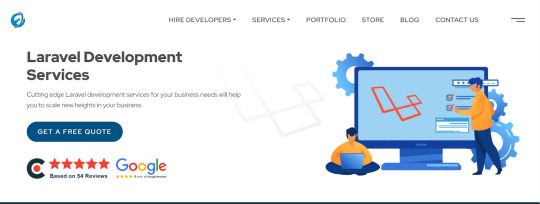
Elsner Technologies is a Laravel development company that has gained a high level of expertise in Laravel, one of the most popular PHP-based frameworks available in the market today. With the help of their Laravel Web Development services, you can expect both professional and highly imaginative web and mobile applications.
Additional Information-
GoodFirms : 5
Avg. hourly rate: < $25/hr
No. Employee: 250 - 999
Founded Year : 2006
Logicspice

Logicspice stands as an expert and professional Laravel web development service provider, catering to enterprises of diverse scales and industries. Leveraging the prowess of Laravel, an open-source PHP framework renowned for its ability to expedite the creation of secure, scalable, and feature-rich web applications.
Additional Information-
GoodFirms : 5
Avg. hourly rate: < $25/hr
No. Employee: 50 - 249
Founded Year : 2006
Sapphire Software Solutions
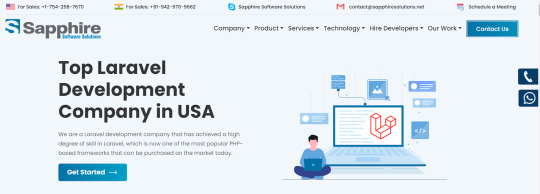
Sapphire Software Solutions, a leading Laravel development company in the USA, specialises in customised Laravel development, enterprise solutions,.With a reputation for excellence, they deliver top-notch services tailored to meet your unique business needs.
Additional Information-
GoodFirms : 5
Avg. hourly rate: NA
No. Employee: 50 - 249
Founded Year : 2002
iGex Solutions
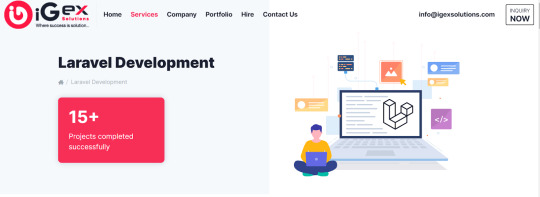
iGex Solutions offers the World’s Best Laravel Development Services with 14+ years of Industry Experience. They have 10+ Laravel Developer Experts. 100+ Elite Happy Clients from there Services. 100% Client Satisfaction Services with Affordable Laravel Development Cost.
Additional Information-
GoodFirms : 4.7
Avg. hourly rate: < $25/hr
No. Employee: 10 - 49
Founded Year : 2009
Hidden Brains
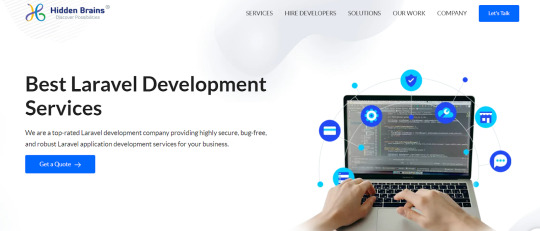
Hidden Brains is a leading Laravel web development company, building high-performance Laravel applications using the advantage of Laravel's framework features. As a reputed Laravel application development company, they believe your web application should accomplish the goals and can stay ahead of the rest.
Additional Information-
GoodFirms : 4.9
Avg. hourly rate: < $25/hr
No. Employee: 250 - 999
Founded Year : 2003
Matellio
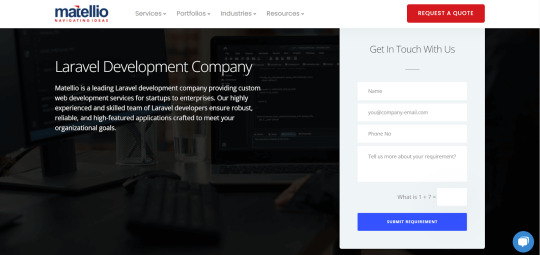
At Matellio, They offer a wide range of custom Laravel web development services to meet the unique needs of their global clientele. There expert Laravel developers have extensive experience creating robust, reliable, and feature-rich applications
Additional Information-
GoodFirms : 4.8
Avg. hourly rate: $50 - $99/hr
No. Employee: 50 - 249
Founded Year : 2014
What advantages does Laravel offer for your web application development?
Laravel, a popular PHP framework, offers several advantages for web application development:
Elegant Syntax
Modular Packaging
MVC Architecture Support
Database Migration System
Blade Templating Engine
Authentication and Authorization
Artisan Console
Testing Support
Community and Documentation
Conclusion:
I hope you found the information provided in the article to be enlightening and that it offered valuable insights into the top Laravel development companies.
These reputable Laravel development companies have a proven track record of creating customised solutions for various sectors, meeting client requirements with precision.
Over time, these highlighted Laravel developers for hire have completed numerous projects with success and are well-equipped to help advance your business.
Before finalising your choice of a Laravel web development partner, it is essential to request a detailed cost estimate and carefully examine their portfolio of past work.
#Laravel Development Companies#Laravel Development Companies in USA#Laravel Development Company#Laravel Web Development Companies#Laravel Web Development Services
2 notes
·
View notes
Text
What is array_diff() Function in PHP and How to Use.
Introduction
array_diff — Computes the difference of arrays
Supported Versions: — (PHP 4 >= 4.0.1, PHP 5, PHP 7, PHP 8)
In Today’s Blog, We are going to discuss about array_diff() function in php. When it comes to working with arrays in PHP, developers often encounter situations where they need to compare arrays and find the differences between them. This is where the array_diff() function comes to the rescue. In this comprehensive guide, we will delve into the intricacies of the array_diff() function, understanding its syntax, functionality, and usage with real-world examples.
Understanding the array_diff() Function:
When working with arrays in PHP, the array_diff function emerges as a powerful tool for array comparison and manipulation. array_diff function enables developers to identify the disparities between arrays effortlessly, facilitating streamlined data processing and analysis.
The array_diff function allows you to compare arrays, pinpointing differences across elements while efficiently managing array operations. By leveraging this function, developers can identify unique values present in one array but absent in another, paving the way for comprehensive data management and validation.
One remarkable feature of array_diff is its ability to perform comparisons based on the string representation of elements. For instance, values like 1 and ‘1’ are considered equivalent during the comparison process. This flexibility empowers developers to handle diverse data types seamlessly.
Moreover, array_diff simplifies array comparisons regardless of element repetition. Whether an element is repeated several times in one array or occurs only once in another, the function ensures accurate differentiation, contributing to consistent and reliable results.
For more intricate data structures, such as multi-dimensional arrays, array_diff proves its versatility by facilitating dimension-specific comparisons. Developers can effortlessly compare elements across various dimensions, ensuring precise analysis within complex arrays.
Incorporating the array_diff function into your PHP arsenal enhances your array management capabilities, streamlining the identification of differences and enabling efficient data manipulation. By seamlessly integrating array_diff into your codebase, you unlock a world of possibilities for effective array handling and optimization.
The array_diff function in PHP is a powerful tool that allows developers to compare two or more arrays and return the values that exist in the first array but not in the subsequent arrays. It effectively finds the differences between arrays, making it an essential function for tasks like data validation, data synchronization, and more.
Note
VersionDescription8.0.0This function can now be called with only one parameter. Formerly, at least two parameters have been required.Source: https://www.php.net/
Syntax:
array_diff(array $array1, array $array2 [, array $... ])
Parameters:
array1: The base array for comparison.
array2: The array to compare against array1.
…: Additional arrays to compare against array1.
Example 1: Basic Usage:
$array1 = [1, 2, 3, 4, 5]; $array2 = [3, 4, 5, 6, 7]; $differences = array_diff($array1, $array2); print_r($differences);
Output
Array ( [0] => 1 [1] => 2 )
Example 2: Associative Arrays:
$fruits1 = ["apple" => 1, "banana" => 2, "orange" => 3]; $fruits2 = ["banana" => 2, "kiwi" => 4, "orange" => 3]; $differences = array_diff_assoc($fruits1, $fruits2); print_r($differences);
Output
Array ( [apple] => 1 )
Example 3: Multi-dimensional Arrays:
$books1 = [ ["title" => "PHP Basics", "author" => "John Doe"], ["title" => "JavaScript Mastery", "author" => "Jane Smith"] ]; $books2 = [ ["title" => "PHP Basics", "author" => "John Doe"], ["title" => "Python Fundamentals", "author" => "Michael Johnson"] ]; $differences = array_udiff($books1, $books2, function($a, $b) { return strcmp($a["title"], $b["title"]); }); print_r($differences);
Output
Array ( [1] => Array ( [title] => JavaScript Mastery [author] => Jane Smith ) )
Important Points
It performs a comparison based on the string representation of elements. In other words, both 1 and ‘1’ are considered equal when using the array_diff function.
The frequency of element repetition in the initial array is not a determining factor. For instance, if an element appears 3 times in $array1 but only once in other arrays, all 3 occurrences of that element in the first array will be excluded from the output.
In the case of multi-dimensional arrays, a separate comparison is needed for each dimension. For instance, comparisons should be made between $array1[2], $array2[2], and so on.
Conclusion
The array_diff() function in PHP proves to be an invaluable tool for comparing arrays and extracting their differences. From simple one-dimensional arrays to complex multi-dimensional structures, the function is versatile and easy to use. By understanding its syntax and exploring real-world examples, developers can harness the power of array_diff() to streamline their array manipulation tasks and ensure data accuracy. Incorporating this function into your PHP toolkit can significantly enhance your coding efficiency and productivity.
Remember, mastering the array_diff() function is just the beginning of your journey into PHP’s array manipulation capabilities. With this knowledge, you’re better equipped to tackle diverse programming challenges and create more robust and efficient applications.
4 notes
·
View notes
Text
Certificate Course in PHP Full Stack Developer at Nextskill Technologies, Coimbatore

In today's rapidly evolving digital landscape, the demand for skilled web developers is at an all-time high. Among the various programming languages, PHP Full Stack has emerged as a powerful and widely-used scripting language for web development. If you are keen on exploring a career in this exciting field, look no further than the Certificate Course in PHP Full Stack Developer offered by Nextskill Technologies in Coimbatore. This comprehensive program is designed to equip you with the knowledge and practical skills necessary to excel in the world of web development. Let's dive into the details of this exceptional course.
Why Certificate Course in PHP Full Stack Developer?
Before delving into the specifics of the course, let's understand why PHP Full Stack Developer is a lucrative and sought-after skill in the tech industry.
Versatility: PHP Full Stack can be seamlessly integrated with various databases, frameworks, and content management systems, making it a versatile language for developing dynamic web applications.
High Demand: Many popular websites, including Facebook and WordPress, are built using PHP Frameworks. The language's prevalence ensures a steady demand for skilled PHP Full Stack developers.
Open Source Advantage: Being an open-source language, PHP Frameworks is constantly updated and enriched by a vibrant community of PHP developers, providing access to a vast array of libraries and tools.
Career Growth: PHP developers can explore various career paths, such as PHP full-stack developers,PHP backend developers, or even specialize in PHP-based frameworks like Laravel or CodeIgniter.
Nextskill Technologies: Empowering Your Journey
Located in the heart of Coimbatore, Nextskill Technologies has earned a reputation as a leading IT training institute with a focus on cutting-edge technologies. Their Certificate Course in PHP Full Stack Developer is a well-structured program that caters to both beginners and experienced professionals looking to enhance their web development skills.
Course Curriculum Certificate Course in PHP Full Stack Developer at Nextskill Technologies is designed to provide a comprehensive understanding of web development principles and practical hands-on experience. The well-organized curriculum includes:
Introduction to Web Development: An overview of web development, its technologies, and the role of PHP Full Stack Developer.
HTML, CSS, and JavaScript Fundamentals: Building a strong foundation in front-end development.
PHP Programming Basics: Learning PHP syntax, variables, operators, and control structures.
MySQL Database Integration: Understanding database design and integration with PHP frameworks.
Object-Oriented PHP: Mastering object-oriented PHP programming concepts and their implementation in PHP.
PHP Frameworks: Exploring popular PHP frameworks like Laravel for efficient development.
Front-end Frameworks: Implementing front-end frameworks like Bootstrap for responsive design.
Project Work: Applying the learned concepts to real-world projects under the guidance of experienced mentors.
Key Features of the Course
Experienced Faculty: The course is taught by industry experts with extensive experience in PHP Full Stack Developer, ensuring a quality learning experience.
Hands-on Training: Practical exercises and real-world projects provide students with valuable hands-on experience.
Placement Assistance: The institute offers placement support and guidance to help students kickstart their careers.
Certification: Upon successful completion of the course, participants receive a recognized certificate, adding value to their resumes.
Conclusion
The Certificate Course in PHP Full Stack Developer at Nextskill Technologies, Coimbatore, is an excellent opportunity for aspiring web developers to gain the skills and knowledge required to thrive in the competitive tech industry. With a well-structured curriculum, experienced faculty, and a supportive learning environment, this course serves as a stepping stone towards a successful career in PHP Full Stack Developer. Embrace this opportunity, and let Nextskill Technologies be your guide on this rewarding journey.
For More Details: https://nextskilltechnologies.com/
#PHP Full Stack Developer#PHP Developer#web development#PHP Programming#Front-end Development#Back-end Development#PHP Frameworks#html#css
2 notes
·
View notes